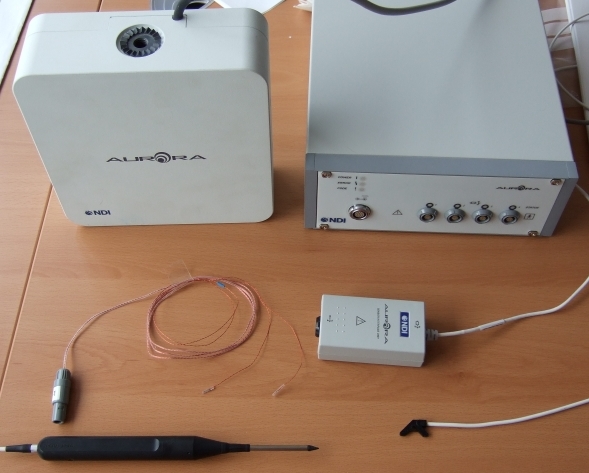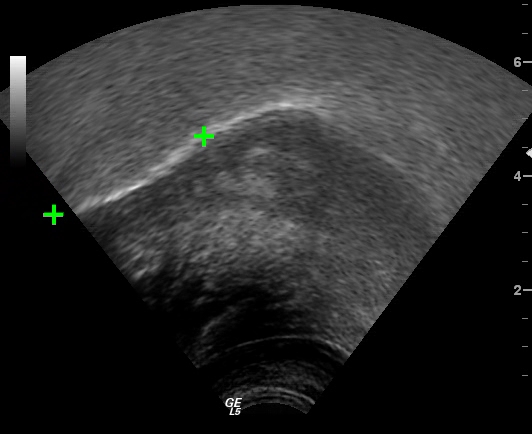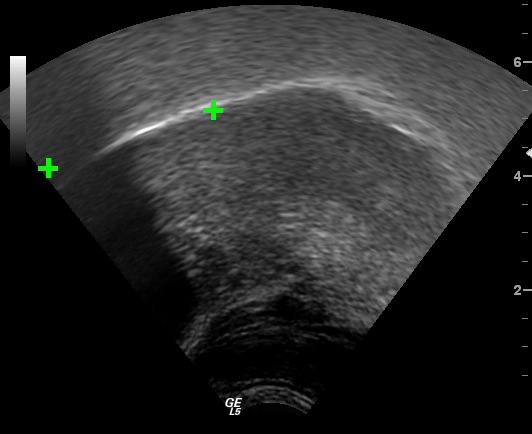 Electromagnetic sensors
Electromagnetic sensors

|
The tracking system is an Aurora miniature electromagnetic
(EM) system. This systems includes a magnetic field generator (MFG),
a system control unit which communicates with a pc on the serial
port, and miniature coils. These coils provide three degrees of
freedom (DOF) in position and two in angulation (in a quaternion
format). Specifications given by the manufacturer quote a positionnal
accuracy of 1-2 mm and an angular accuracy of 0.6 degree within the
sensitive volume where the MFG emits (approx. 50 cm x 50 cm x 50
cm).
|
 Ultrasound images
Ultrasound images
A Logiq5 ultrasound (US) machine from
GE Healthcare is used. Our
transducer is a microconvex 8C probe, producing ultrasound between
5MHz and 9MHz. The idea is to use this probe on a speaker chin to
acquire images of the shape of the tongue. As the tongue is located
between 3cm and 7cm from the chin during the speech production, the
obtained acquisition for US images can vary between 50Hz and 100Hz,
depending on the scanning area, the depth of penetration, the
precision of the image...


 Why mix US and EM data?
Why mix US and EM data?
During speech production, there is often an air cavity below the
tongue: the US technique is not able to get the whole shape of the
tongue because US can't cross air cavities. Areas such as the tip of
the tongue (the apex) can't be tracked with the ultrasound
only. Therefore, the idea is to put an EM coil where the US can't
track the tongue in order to be able to recover a larger part of the
tongue.
The idea is to superimpose EM data on US images. One 5DOF
coil is glued on the tongue apex. To check if EM sensor can track
movements of the tongue on US images, another 5DOF coil is glued on
the middle of the tongue.
 EM-US coupling
EM-US coupling
EM data need tobe spatially and temporally calibrated into the US
system. It means that the spatial transformation between the US and
The EM system coordinate need to be computed (this a rigid
transformation, i.e. a translation and a rotation), and a temporal
calibration has to be done in order to get the same time sampling for
the two modalities.
 Experimentations on the tongue
Experimentations on the tongue
- Sequence 1: /au/, /atu/, /aku/, /ao/, /ako/, /ae/, /ake/, /ate/.
- Sequence 2: "La bise et le soleil se disputaient, chacun assurant qu'il était le plus fort"

|
Sequence 1 with sound
|

|
Sequence 1 mixed with a video acquistion of the experimental set-up
|

|
Sequence 2 without sound
|

|
Sequence 2 with sound
|
 Electromagnetic sensors
Electromagnetic sensors
 Ultrasound images
Ultrasound images

 Why mix US and EM data?
Why mix US and EM data? EM-US coupling
EM-US coupling Experimentations on the tongue
Experimentations on the tongue


